
The main old building of Lund University — Photo taken from in front of the Academic Union by friend Hilde Metzger — Great thanks, Hilde.
Lund is my spiritual home in Sweden and I can not imagine a city filled with more history, charm and beauty. Whenever I get back I love to walk around in the historical area in the center of the city. The Cathedral, the University, the Academic Union, “the KIng’s House” (Lundagårdshuset). All of those make up the nucleus of this unique city. More historical buildings could be added to this list though. The list is long.
The present main university building dates from the late 19th century,. However, Lund University dates from 1666, very shortly after four southern provinces were won over from Denmark through the peace of Roskilde. All of those university buildings together make up the center of my universe. Athenaeum, usually called Athen, in the Academic Union building has sadly been totally changed. It has become a selling place for all sorts of things, clothes and whatnot. It used to be a very friendly place in my days where students met, read a paper, had a cup of coffee, chatted, played chess, backgammon or whatever.
This university center will forever remain so much a part of my past and my youth that it is truly part of me. And beside the buildings, there is the most wonderful Lundagård, a park that goes back to the Danish era and the 16th century. It is right next to the university and the King’s House , covering the area down to the Cathedral, with its several hundred-year-old elm trees. I even had a few of my classes in this 16th century old building, the French seminars, among others.

My university, the white building seen behind wintry trees, and the 15th century King’s House on the right
Lund is one of the two oldest cities in Sweden, the other one being Sigtuna, close to Stockholm. According to Danish history, the City of Lund dates from 990. From 1103 it was the seat of an archbishop.
At the center of the city stands the towering Lund Cathedral, built about 1090-1145. It was restored the first time in the 16th century. It was again restored and very important work begun in the mid 19th century. It was not entirely finished until 1893. (Lund Cathedral, Wikipedia)
The Christianization of Sweden took place in a somewhat haphazard way – it began in the south, but also the apostle Ansgar was spreading Christianity from the island of Birka in Lake Mälaren, the first small town that later grew to become Stockholm.
The bishopric of Lund only became part of Sweden after the Treaty of Roskilde in 1658, which turned the four southernmost provinces over to Sweden. Skåne (Scania) in the very south was the most important province, with its cities that thrived within the Hanseatic league 1.
Lund Cathedral became a center for Christianity for all of Scandinavia. In fact, Lund was an important city even before the first cathedral was built. The bishop of Lund became the first archbishop for all of Scandinavia in 1104 and the construction of the cathedral was begun sometime after he took office. The ancient crypt has been unchanged since 1123.
The cathedral is one of the wonders of Lund and many legends are tied to this old building. There was, in pagan days, a giant named Finn (jätten Finn) who fought against Christianity. He had enormous strength but this strength was dependent on nobody knowing his name. However, one day a monk walked by in the hillsides where his wife was singing a lullaby to their son, saying ‘”Lie still, baby mine! Tomorrow cometh Fin, Father thine”. The monk hastened to Finn and said ‘I know your name. You are Finn and now your strength is broken.’ Finn got furious, went down into the crypt of the cathedral and wrapped his arms around a pillar in order to break it and destroy the cathedral. But at that moment he was turned into stone, and that is why there is a stone man hugging a pillar in the crypt of the Cathedral in Lund to this day. Well, so goes the legend.
_____________________
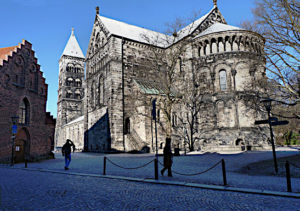
The apse of the cathedral remains almost unaltered from the first cathedral building. The eastern wall of ‘Liberiet’ on the left.
A funny thing comes to my mind when I go back to all my wanderings past the cathedral in my student days. A huge black long-haired dog, most likely a Newfoundland, would always be lying peacefully right on the corner of the paved area in front of the cathedral, close to the street. It was the dog who belonged to Professor Siwe, who lived right across the street on Kyrkogatan (Church street). Obviously the professor let him out every morning to spend his day in the open air. Siwe was a professor in pediatrics and a well-known personality in Lund.
The dog must have been pretty old even in my days since he never budged, always taking the same position on that same corner on Kyrkogatan, across from Klostergatan. Later on when I came back to Lund during my first marriage, I can’t remember seeing the big long-haired dog any more. He was so much part of the scene in the very center of Lund, and it was well known that he was Professor Siwe’s dog. He might well have been missed after he went to dog heaven. An institution was gone.
____________________
Lund as a university city is fabulous. It is unique in the world of its kind. And I am not exaggerating. The small town center is so totally dominated by the university that it IS the university. The medieval buildings, the center so totally dominated by the tuniversity, the Academic Union (Akademiska Föreningen, AF), the superb Romanesque cathedral, the wonderful park, Lundagård, and, not to be forgotten, Kulturen, the open-air historical museum. In size it can not compare with Skansen on Djurgården in Stockholm, but it has a wonderful collection of very old south Swedish houses and buildings. It is a marvelous experience just to wander around inside Kulturen, bending your back to get through the low door openings to the oldest and smallest houses, admiring the fancy and also the simple old carriages, having children ride on the rocking horse of Karl XII and just enjoying the serenity and beauty of the museum.
I loved the university and even some of the classes. The old building that is called the King’s House, where we had some classes, is a historic landmark. The steps were very low to begin with and they are now also very worn down in the middle of each step.
So did Karl XII ride on horseback all the way up to the tower, or is it just a tale? We don’t really know. — King Karl XII was killed in a battle outside Oslo in 1718. The end of his senseless wars brought to a close Sweden’s seventy years as a great power.
This historic building was constructed by the Danish king Frederick II between 1578–84 when Skåne was part of Denmark, and was originally intended as the residence for the bishop of Lund. After the secession of the four southern provinces to Sweden in the Treaty of Roskilde in 1658, and the foundation of Lund University shortly after 1666 to enhance the Swedification of the former Danish provinces, the building was incorporated to serve as the university’s main building and library. For a time the tower also held an observatory.
An old saying goes that Lund lives on professors’ widows, the widows live on the students, and the students live on loans. But that was before all the dormitories grew up all over the city, dormitories built and financed by the ‘nations’ — at the beginning, a term borrowed from the Middle Ages and Paris when, at the Sorbonne and also other continental universities, there actually were several nations represented in the student body. And the students supposedly communicated in Latin.
The ‘nations’ at Lund University simply represent provinces or even major cities, and mine was of course Småland’s Nation, since most of my ancestors came from Småland, and that was also where I was born. More and more of these very comfortable dormitories were built not only by ‘nations’ but also by the Academic Union. I did though rent a room with families for a couple of years before I managed by hook and by crook to get a foot in the door to my nation’s board (by helping to move chairs for our big parties). I later got a post as an organize of parties, called, as if by a typical student joke, sex master and sex mistress. And you begin by being the vice- mistress or master.
The academic center of Lund is the most wonderful city center I have ever known. The major edifices are set around a beautiful fountain in a small park and there are also the old buildings that were there even before the university was constructed in the 17th century. There is the King’s House, as has already been mentioned – late 16th century – situated at the edge of the central University area and also at the edge of the wonderful park, Lundagården, with a great number of dignified elm-trees that are hundreds of years old. Fountains, statues, everything perfectly well arranged and, in my days, hundreds of bicycles in front of the Academic Union.
The interior of the Academic Union was renovated completely the year before I started my studies, while I was in France. We now had a huge hall for students’ recreation, tables and chairs all over, games like chess and bräde, an old Swedish variation on backgammon, on the side by the big windows that open onto the University and the huge fountain in front of it. There was of course a counter where hot and cold drinks could be bought. This social gathering place was called Athen (or actually Athenaeum) and while it was under reconstruction (probably two years’ work), the students were confined to a much smaller recreation hall that was called – what else – Sparta.
Liberiet, the small red brick building just south of the cathedral, dates from the 15th century. It was first used as a library for the diocese and later, after the university was founded soon after 1666 — after Skåne had become part of Sweden — Liberiet was taken over by it and was used by the Faculty of Arts. It is now a quiet gathering place for ‘pilgrims’ who come from far away to socialize and find peace.
There are also many other centuries-old houses — Wickmanska gården is not to be forgotten. It is situated right next to the “apse” of the university on Kyrkogatan and Paradisgatan. Also the very old building for what became, during my student years, the greatly appreciated restaurant Stäket on Stora Södergatan may well be mentioned. There are, however, innumerable historical houses in this medieval town.
What makes Lund so remarkable is the way it is still today pretty much unchanged in the center, even though it is growing fast on the outskirts. For the huge student events, such as the Carnival, which takes place every four years, the center of Lund IS Lund. The outlying areas are just unimportant living areas and some clean industry.
_____________________
There were many things going on within the university and the Academic Union that had very little to do with teaching and learning, such as big dances, where in those days we wore evening wear for the big occasions. And there were smaller events, by nations, such as the reception for the Hungarian refugee students in 1956 in Småland’s Nation’s basement that was arranged for parties (gillestugan).
I will forever be indebted to my long-time friend from Gymnasium, the law student, Karin, for waking me up from my general listlessness of those years and getting me to come along with her to lots of these student evenings (studentafton). There were many of those student evenings, performances that left durable memories and that I wouldn’t have missed for anything. But in fact I would have missed them if it hadn’t been for my friend Karin. She ended up as an important judge in Norrköping.
There were lots of interesting people coming to perform. Theater groups and jazz bands, for instance, were performing on the big stage in the recently rebuilt interior of the Academic Union, where a huge hall (stora salen) served multiple purposes, as a theater, as a banquet hall with masses of tables and as a dance floor when a huge soirée was held.
I remember vividly such a big party, co-sponsored by Småland’s nation and Lund’s nation (if I remember right). It was a fancy-dress ball. Since my stepfather, Arne, had been given a lot of old but beautiful costumes by the Royal Dramatic Theater for his own theatrical school productions at his school in Nyköping, I borrowed one that our great actress, Inga Tidblad, had worn in ‘The Taming of a Shrew’. But I have already mentioned this in another chapter. I was more beautifully dressed for that ball than I had ever been in my life.
Mentioning the great Inga Tidblad makes me think of all the unforgettable theater performances I have seen at the Royal Dramatic Theater, but I’ll get back to that later.
Often an intellectual evening was arranged, as when the famous theater and literary critic, Harry Schein, in 1956 had proclaimed in the incomparable intellectual monthly magazine Bonnier’s Literary Magazine (Bonniers Litterära Magasin]) ‘Jag är trött på film’ (I am tired of movies). He was invited to a student evening with several other notables, among them Ingmar Bergman, then the Artistic Director of Malmö City Theater. (‘Cat on a Hot Tin Roof’ by Tennessee Williams and ‘Peer Gynt‘ by Ibsen were among some of his most remarkable stage productions.)
These were the days before most of Ingmar Bergman’s world-famous movies hit the screen, but he was still an outstanding celebrity. There was also Carl-Anders Dymling, director for Svensk Filmindustri, the multi-activities cultural center figure and journalist, Harry Schein himself, who grew up in Austria and never lost his little German accent. And there were others.
Bergman had been promised, as a condition for his presence at the event, that he would not be called on to speak. I remember how he was the only one dressed in a dark turtle-neck sweater, no jacket, very typically. After a few speakers had gone by — Harry Schein (long-time husband of the famous actress, Ingrid Thulin), and a couple of others — Ingmar Bergman was of course encouraged to say a few words anyway, though he did not fail to point out what he’d been promised..
There was a performance by our own Students’ drama club (Lunds studentteater) of the ‘Three Penny Opera’ by Bertold Brecht and music by Kurt Weill. However, since I have the Three Penny Opera in my blood, I’ll get back to it elsewhere. Die Dreigroschenoper is Bertold Brecht’s wonderful beggar’s opera that I got to know well when I grew up. It is an adaptation of “The Beggar’s Opera” written in 1728 by John Gay.
In 1957 there was a wonderful performance of Stravinsky’s L’histoire d’un soldat by Malmö City Theater performed in the classical way, the soldier telling his story to the audience while the music is playing behind him. It is based on a Russian folk tale and is a parable about a soldier who trades his fiddle to the devil in exchange for a magic book. I had never seen it before and I was mezmmerized. The devil is also on the stage, but I mainly remember the soldier telling his story. I loved the music and the talking going on together.
There was a jazz evening with the only Swedish jazz musician of that time who could hold his own next to the world famous Arne Domnerus – called Dompan by the boys in our group of adolescent Gymnasium students. We usually got together for fun and dance on Saturday evenings in our homes, very often in mine.
This jazz musician was Carl-Henrik Norin and he had brought wonderful Brita Borg singing one of her most famous numbers ‘Fat Mammy Brown’, dressed up as an Afro-American gospel singer with a brown face and rich padding around her body. Brita Borg was wonderful and she brought the house down.
Brita Borg was the best Swedish jazz singer after Alice Babs, who became an international star. Alice Babs got to be almost as renowned for her scat singing as Ella Fitzgerald. The first time I saw her was during the war when I was just a little girl. She was performing in a park off Regementsgatan, close to where we lived at the time and we were simply standing around listening to this young teenager singing swing and yodeling. I don’t even know if there was an entrance fee, but probably there was . She was fun and she was good, but little did we suspect that this young girl was going to become an international star and act in numerous movies. Alice Babs in Sweden WAS swing. And she was a wonderful jazz singer.
There was the wonderful jazz ballet ‘Frankie and Johnny’ choreographed by C. G. Kruuse, in November 1955. Carl-Gustaf Kruuse was not Alvin Ailey, but it was my first jazz ballet and I loved it. Kruuse, usually a rather traditional choreographer at Malmö City Theater, this time outdid himself. It was real jazz ballet and I was bewitched.
At another student evening in 1955 we saw the most extraordinary performer, also a first for me, the masterful mime, Marcel Marceau. It was like magic, ‘seeing’ him open doors that were not there, getting into a room that wasn’t there, sitting down on a chair that wasn’t there… Or sensuously dancing with a woman when he was alone on the stage. I saw him again in New York City and I could never tire of a superbly skillful mime like Marcel Marceau.
A couple of decades later, in San Francisco with John, we saw mimes that had certainly been influenced by Marcel Marceau, although very different. Outside a central theater in downtown S.F. there were numerous mimes standing absolutely still for hours, or so it seemed, painted white like the French master of mime. but no sketches there. Quite memorable, nevertheless.
______________________
The most traditional entertainment form in Lund was by far the spex (an ancient abbreviation of spectacle), created by a group of men called Lundaspexarna. Those amateur comedies were deliberately vulgar parodies on Latin and Greek dramas and the ’modern’ form of spex dates from the years in the mid 19th century when classical studies were far more central at the universities than they are today or were in my days. Uppsala was actually the university where the spex was born around the middle of the 19th century, but Lund opened up to the tradition a couple of decades later 2
Today there are at least four universities in Sweden where the spex has long-running traditions. All the actors have always been men and they still are, and this is of course partly because of the link to antique Greek theater.
Calling the spex musical comedy is altogether misleading, since there’s1 no comparison whatever between a spex and this American form of entertainment which I have never been an ardent admirer of. The long-haired hippy and rock musical “Hair” is the outstanding exception to my general down-putting of musical comedies. I did not see Hair until 1968 on Broadway but friends of mine had seen it off Broadway at Joseph Papp’s own theater and strongly urged me and my then husband Allyn to go and see it. And, oh yes, “West Side Story” must be added to the exceptions, and also “My Fair Lady“. If I tend to leave those out it is because I only saw them as movies, not on Broaway.
I later saw it in 1970 in Paris, with my sister Gun in a totally different production. It was beautifully staged and not uninteresting, but it didn’t have the spark and the cheekiness of the New York production.
Among the most famous spex is Uarda, the Egytian Pharaoh’s daughter, and also Djingis Khan, which was first written and performed for the carnival (‘my’ carnival) in 1954. Uarda dates from 1908 but is not quite the oldest spex in Lund. Gerda dating from 1886 is the oldest one. However, the success Uarda has met with for over a century is unparalleled. It is renewed every five years and it is always an exceptional event.
Since all the parts are played by men, singing and talking taking turns throughout the play, the love scenes become absolutely hilarious. The reason why only men are acting is not only because of the tradition from antique Greek theater being picked up, but also because in the early 20th century there were no women at the universities. And even less so in the 19th century.
Uarda, correctly ‘Uarda eller Sfinxens spådom‘ (Uarda or the divination of the Sphinx), is a Lund student spex set in ancient Egypt. It has been said to be the most beautiful flower in the Lund spex flora. Uarda is the name of the Egyptian Pharaoh’s daughter in a novel by the same title written by Georg Ebers (1876), and on which the libretto of the spex is based. But the lyrics are typical for the kind of Lund student humor that is at the center of all spexes. The acting is a wild parody of Offenbach operettas and the like, but more specifically Offenbach. “La belle Hélène”, which is a spoof in itself, was a perfect example to follow while going much further in comical effects.
_________________________
The year I got back from France, I had the enormous luck to be invited to the big party of the Lundaspexare in the banquet hall (stora salen) at the Academic Union. It was not in any way thanks to any merits of my own since I did not know any of the “spexare”. However, a Frenchman had arrived from Paris, invited by my sister’s medical-school friend Maggan. Since he spoke no Swedish and they, Maggan and her main spexare friend, nicknamed Spuling, spoke no French, it was considered a bright idea to get me, newly back from seven months in France, to serve as a guide for this Marcel, who sold arts objects and was a minor artist himself. So Marcel and I were invited to attend the wonderful soirée where I heard now legendary Cilla Ingvar for the first time.
In May of 1953 Marcel and I joined the huge crowd in the banquet hall in the newly rebuilt Academic Union. The salle was crowded and everybody was standing up in this sea of students, spexare and people like me, just invited audience. A stage had been built up on the long side of the big hall and Cilla Ingvar was the event. I was new at the university and it was the first time I heard her name. Her most famous song, ‘Susie fra København’ was a song in Danish written by Crüll Fältström who wrote many songs for Cilla over the years. In her powerful and sexy voice she sang about this Copenhagen high-class demi-monde with a bravura that I had never heard the like of.

Susie fra København is timidly looking out from behind a pillar in the atrium of the Academic Union (Photo medialive.se)
Susie fra København (by Crüll Fältström)
Jeg er fra Köbenhavn
jeg er fra Kongens by
og hvis du lide mig
så kommer jeg til dig
(I am from Copenhagen
I am from the King’s city
And if you like me
I’ll come to you)
To be perfectly truthful, I am only sure of the words in the first two lines, but the meaning of what she was singing is what I have put into my own words here in Danish. Mig and dig are pronounced in Danish more or less like my and thy, but meaning me and thee.
The audience went wild with applause and hurrays.
Followed Kolasången – The toffee song, ’Får jag bjuda en kola på dej?’ (May I offer a toffee to you?). It wasn’t even an anti-climax after Susie fra København brought the house down. I admit I don’t recall the tune of this one, but Cilla was the incomparable star once again.
More about Cilla Ingar
Cilla was the daughter of the professor in practical (internal) medicine, Sven Ingvar, who was an old friend of Karl Gerhard, the illustrious Swedish King of revues (vaguely = cabaret). Her father died when Cilla was only 16 and it seems likely that Karl Gerhard was a kind of father figure for her after that. However that may be, Karl Gerhard had seen and heard her and he made her his prima donna in 1955 in a New Year’s revue at the Cirkus theater on Djurgården, one of the most beautiful islands in Stockholm, where lots of theater and cultural sites are located.3
They later appeared several times at China theater located at Berzelii Park Stockholm, where I saw her again with my first husband, Roland, a couple of years later in this totally different milieu. I was quite nervous, wondering if she would really be up to following in the footsteps of the great (though somewhat infamous) Zarah Leander. I didn’t need to worry. She was completely up to the task. Once again, she sang, among other songs by Karl Gerhard himself, her incomparable ‘Susie fra København’ and, once again, it was met by thunderous applause. Her fabulous stage presence combined with a voice that could wake the dead and her musicality assured her the admiration of Swedish theater goers at large.
So this magnificent student revue star went on to become a great revue prima donna for the most famous Swedish King of revues ever, Karl Gerhard. “Revue” is a very particularly Swedish form of intellectual / humorous / show biz entertainment with lots of wit and ridiculing of politics and current events of the day.
Cilla worked with the King of revues until 1963 when she got married and changed her role to becoming a mother. She didn’t entirely give up on singing on various stages though. Even as late as in 1978 a friend of hers managed to get her back up on the stage, this time in Göteborg at Liseberg, the wonderful Göteborg amusement park. She had important functions for Sveriges Radio (the Swedish Radio) and also became a writer and a diversified cultural persona.
_________________
However, in spite of my enthusiasm for Cilla Ingvar, the biggest event during my student years was, after all, the Carnival in 1954. It went on for three festive days in May, as it always does, and it was unforgettable. It is impossible to transmit a feeling of what a Lundakarneval is really like, unless you have been there once. The enormous parade (karnevalståget) is just one of the great events, but it goes on, and on, and on. Everybody ‘known’ in Sweden is made fun of, royalty of course, politicians, Swedish historical figures, popular singers, entertainers of all sorts. It was an endless parody on everything that could possibly be held up to be laughed at in Sweden at the time. And there was a lot.
This carnival, the biggest one of all times, was called Skandalkarnevalen, probably because the royals were mercilessly made fun of, among others the present king, Carl XVI Gustaf, who was then 8 years old and became king in 1973. The parade was spectacular and my friends and I spent hours laughing at all the droll floats, not filled with flowers, but with parodies of celebrities, Viking maidens with long tresses, hula-hula girls, Tibetan monks and you name it.
There was a new spex, Djingis Kahn, which I only vaguely remember, except for a few songs. It got to be one of the most famous spexes in Lund and is performed every five years, the same as Uarda, which will always be my favorite spex. It came back in 1958, my last year in Lund. It is absolutely hilarious, the lyrics, the rhymes, the senselessly funny love scenes.
And there was the Lundarevue, cabaret, circus, a carnival movie, no end to the 3-day entertainment. Cilla Ingvar was a drum major in the parade and got more attention than anything else, she was the prima donna in the revue and an actress in the carnival movie.
No student worked during those days and the carnival dizziness stayed with us for a long time.
More about Kartl Gerhard
Karl Gerhard (1891 – 1964) is a legend in Swedish cultural entertainment. He was not by any means the only king of revues; there were others before and after him – and at the same time. But Karl Gerhard was in a class of his own. For his wit, for his political engagement and for his great prima donnas. His strong anti-Nazi stand in a song (called a kuplett in Swedish, for this kind of politically inspired song for the stage) earned him the attention of the mass media, since his song Den ökända hästen från Troja (the infamous horse from Troy) 4 in 1940 was banned by the cowardly Swedish government as being too openly anti-Nazi. I knew the song from a record we had at home, Arne being a great fan of Karl Gerhard, even before he got to know him personally. It was of course intended to stir up the Swedish people (and government) from their collaborationist stand to Nazi Germany.
Karl Gerhard was truly a genius. His wonderful and often biting wit and his great sense of humor made him stand out among even the greatest of our cabaret performers. Add to that his amazing knowledge of Greek and Roman classical cultures, the “Iliad” in particular in the case of ‘The infamous Trojan horse’, and you get an entertainer who is unique.
He considered himself a Communist, but was probably just about the richest Communist ever. His home at least during my days in Stockholm was a huge villa in Saltsjöbaden, which is a most exclusive Stockholm inner archipelago suburb. In 1949 he adopted a very pretty little Ethiopian girl, called Fatima, born in Copenhagen, and all Swedes loved him all the more for that.
Before the war Karl Gerhard‘s greatest prima donna was Zarah Leander, a legend in herself, but a self-damning one in her decision to move to Nazi Germany before the war where she then became their greatest movie star and cabaret singer, the Aryan star under the protection of Goebbels.
However, Karl Gerhard, the self-styled Communist and outspoken anti-Nazi, wasn’t above compromising. Zarah was shunned by the Swedes for many years after the end of the war (She moved back to Sweden when her house in Berlin was bombed in 1943.), but in 1952 Karl Gerhard took the momentous step of having her as his prima donna again. That year the twosome appeared – oh so innocently – at the Cirkus theater in a revue as the ’sweet old couple from anno dazumal’ (Det rara gamla paret). Zarah sang ‘I am a prima donna from top to toe’ and ‘Vill ni se en stjärna, se på mej’ (If you want to see a star, well look at me!) in her husky voice and with a bravura that made us believe that she had completely forgotten about her Quisling days. Maybe, maybe not. Some people forget easily.
Roland and I saw her sing Vill ni se en stjärna in a Karl Gerhard revue in the late fifties, when Zarah was still very good-looking and had the stage presence that had made her famous. However, I was greatly relieved when Cilla Ingvar replaced her, a young star with her very own style and one that I had loved since my days as a student in Lund. I had never been a Zarah Leander fan. She was too vulgar in my view. I probably could never forgive her for her years entertaining Nazi Germans with Goebbels’ benediction.
Arne, my stepfather, knew Karl Gerhard from the world of theater. Arne, in fact, knew everybody. I don’t think he held it against Karl Gerhard that he had actually wanted to take the great Zarah back, the prima donna of all times. I guess Arne was capable of compromising too.
I don’t think many people today know of the great French cabaret singer Mistinguett (the spelling she finally ended up with of her artist’s name). She was about fifteen years older than Karl Gerhard, but they knew each other well, and Karl Gerhard invited her to come to Sweden on at least one occasion.
Arne told me a very cute little anecdote from her first look at Karl Gerhard on the stage. She was watching him, her good friend, from the wings as he did his routine, which was always singing a ‘kuplett‘, which in Karl Gerhard’s case was always in the witty political-satirical genre, performed with a superb stage presence. He also regularly made fun of locally scandalous events with a political overtone. As Karl Gerhard came off the stage, Mistinguett looked at him with a big smile and some surprise and gave him her judgement as a seasoned cabaret artist: “Charles, tu es bon!”. She must have thought that a little country like Sweden could not produce a cabaret artist who was up to the standards of herself and one of her very best friends, Maurice Chevalier.
I am not particularly fond of Mistinguett’s singing voice, which in my view was too strident in the French way – much more so than Edith Piaf, whom I definitely prefer as a singer. But Mistinguett was the most illustrious French cabaret singer, the highest paid entertainer ever in those days – and with the most highly insured legs. She never failed to show her legs in her sketches.
I can be very sure that she visited Sweden since I actually saw her myself in 1944 or 1945 at the Amusement Park in Malmö (Malmö Folkets Park). I remember her star figure on the outdoor stage, but I can’t remember if I liked her voice at the time or not. I was just a child anyway. Cabarets in Paris went on performing during the war, partly for the entertainment of the German military, but she might still have been tempted by a stint in Sweden. In war-torn Paris money was certainly not growing in the streets, and traveling across continents was out of the question for quite a few years. Mistinguett can probably be compared to a Marlene Dietrich — obviously from an earlier generation — but not nearly as elegant or sophisticated.
What I remember with a laugh is how Arne and Mother were coming to Stockholm from Nyköping for Karl Gerhard’s 70th birthday party. After they got settled in their hotel room, Mother discovered she had left her high-heeled shoes behind in Nyköping. Panic. What do we do now? They called me in the suburb of Stockholm where I lived with my husband Roland, and we drove to their hotel as fast as we could, with two pairs of shoes. Luckily Mother and I had the same size of shoes. Okay, the evening was saved for Mother and all she did was make fun of Zarah Leander for wearing her mink coat the entire evening. Well, I said, maybe her dress had split in the back or something. That’s the closest I ever got to the great King of revues, except from being in the audience.
Continued: Chapter 10 — Stockholm theater
- The confederation of merchant guilds and their market towns – Malmö, Ystad, Stockholm, Göteborg and a host of medieval cities around the Baltic Sea and the North Sea. Hansa, originally a German merchant league, dominated trade along the coasts of Northern Europe ↩
- The first “spexes ” were made as early as in the 16th century in Uppsala, Sweden. Local students were practicing Latin by making Latin plays which were called spex. Since all the students at that time were men, all the actors were men as well. ↩
- Chapter 24 (Part 2) –– Stockholm and some history ↩
- Youtube – Den ökända hästen från Troja by Karl Gerhard ↩


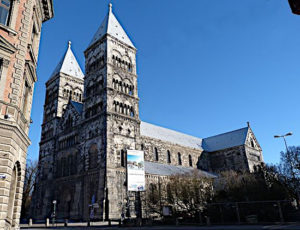

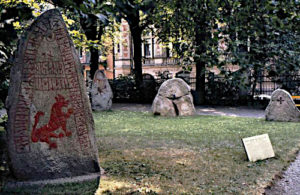
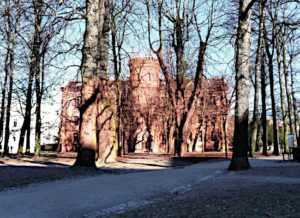
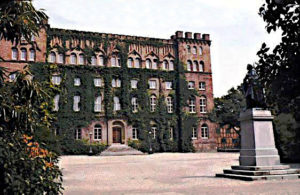
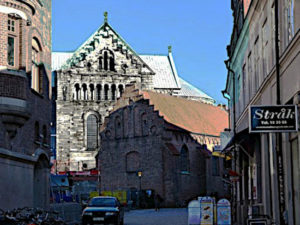
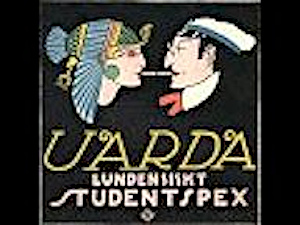
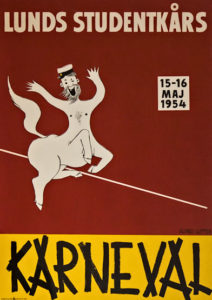
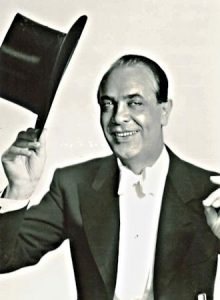

I really enjoyed reading Chapter 9 and learned so much about Swedish culture and entertainment that I would have otherwise never known; likewise it is nice to know about this part of your journey. What wonderful experience and opportunities you’ve had in your life! I knew nothing about the history of Sweden and Lund sounds so charming … magical … in so many ways, from the architecture to the university scenes to the theatre, spex and music.
I love your description of Marceau’s performances, “… like magic, ‘seeing’ him open doors that were not there, getting into a room that wasn’t there, sitting down on a chair that wasn’t there… Or sensuously dancing with a woman when he was alone on the stage.”
I share your distaste for most musical theatre in the US – the only two exceptions being Jesus Christ Superstar and Hair, probably a result of my interests, time and place in life.
This memoir is extremely well-written and presented … Fun! I’m sure that some culture and travel magazines would eat it up!
Restored: Original comment on 18 March 2013 at 19:38
It is impossible to read this without getting a very clear picture of Lund. The area around the university sounds to be beautiful and it is not hard to see why you love it so dearly.